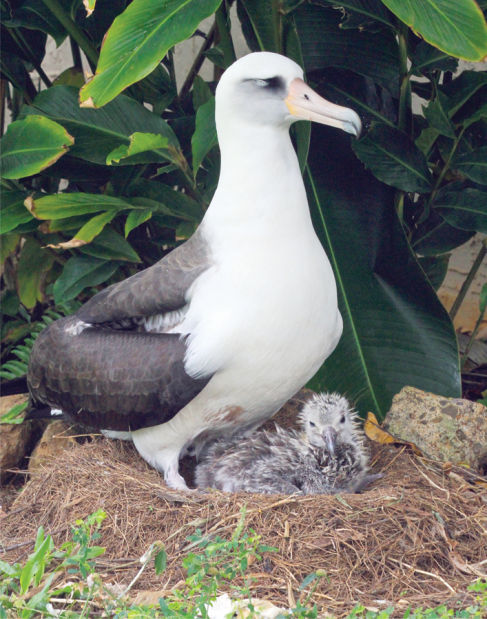LIHUE — The newborn Laysan albatross squirms from underneath its mother’s wing and shakes its awkward head. The parent quickly jumps to its feet, allowing its two-week-old, seemingly annoyed chick to readjust before plopping back down on its fluffy, porcupine-looking
LIHUE — The newborn Laysan albatross squirms from underneath its mother’s wing and shakes its awkward head.
The parent quickly jumps to its feet, allowing its two-week-old, seemingly annoyed chick to readjust before plopping back down on its fluffy, porcupine-looking body.
The chick, named Kaloakulua, was born Jan. 27 on a private North Shore property and has unknowingly become the star of a first-of-its-kind, Truman Show-like experience.
Everything the chick and its parents do around their nest is being captured by a high definition camera and streamed for the world to see. It’s part of the Cornell Lab of Ornithology’s Bird Cams project.
The camera went live the day the bird hatched and is being monitored by the Cornell Lab — at the New York Ivy League university. It is the world’s first Laysan albatross live streaming NestCam, offering a never-before-seen glimpse into the complex social lives of these nesting birds around the clock.
“Nobody has ever seen an albatross grow up like this,” said Hob Osterlund, founder of the Kauai Albatross Network, which is also involved in the collaborative project.
Charles Eldermire, project leader of Bird Cams, said it’s all about pushing awareness for the birds by giving people a real life look. Rather than thinking of it as a virtual experience, he said Bird Cams are a window into the animals’ everyday lives.
“Providing this immersive, intimate view is a connection that most people aren’t able to have,” Eldermire said.
An hour or so of watching and the viewer will see a surprising amount of activity — from preening and feeding to long naps and nest repairs.
There are even emotional family reunions when one parent returns to the nest from an extended fishing trip at sea.
In the 10 days after Kaloakulua’s birth, the website saw 140,000 unique users from 120 different countries, according to Osterlund. And she expects that number to reach more than 1 million by the time the bird fledges this summer.
Osterlund, an award-winning writer and photographer, said there is plenty to be learned from these animals.
“Let’s start that list,” she laughed. “Patience. Faithfulness. Flowing with things as they occur. Non-resistance. Affection. Tenderness. Unflinching courage in the face of all kinds of storms. And an unwillingness — or inability — to see enemies.”
Like people, each albatross has a personality of its own, said Osterlund, describing the new chick as gregarious, active and curious.
“It wakes up and it looks around,” she said. “It’s already rebuilding its own nest. I think this chick is going to be a personality.”
The chick’s mother, named Kaluahine, and its father, Kaluakane, both fledged in or before 2003 and were banded as adults in Kilauea in 2008. Although those involved don’t know their exact ages, they are at least nine years old.
Their first recorded nesting on the property was 2012-2013, but the egg failed to hatch.
On Nov. 11, 2013, the male was spotted back at the North Shore property. The female returned the following day, and house guests on the property reported seeing the birds mating less than a week later, according to Osterlund.
All three albatrosses were given names by Sabra Kauka, the Hawaiian studies kumu at Island School, during a blessing ceremony Jan. 22. The chick, Kaloakulua, is named after the phase of the moon before it started pipping from its shell.
Eldermire said one quick observation he had is that the birds govern their lives much like human beings, doing what’s necessary to provide for their families.
Before the egg hatched, for example, the female sat on the nest without eating or moving for 11 straight days.
And then there are the reunions, when one parent returns to the nest after several days at sea.
“There’s all of this just physical intimacy between these birds — preening each others faces,” he said. “There’s really this sense of physical closeness.”
In just two weeks, the chick is already getting fatter. Although it won’t really fit underneath its parents anymore, the parents keep trying.
Above all, Osterlund said she wants people to know that these birds are here on Kauai and that “we are blessed to have them.”
“We have a chance on Kauai that no one else has,” she said. “We want our web to get way wider and way deeper for everyone to get a chance to see the gorgeous, wise nature of these birds.”
For more information or to view the live webcam, visit cams.allaboutbirds.org. For more information about the Kauai Albatross Network, visit www.albatrosskauai.org.
• Chris D’Angelo, environmental reporter, can be reached at 245-0441 or cdangelo@thegardenisland.com.


